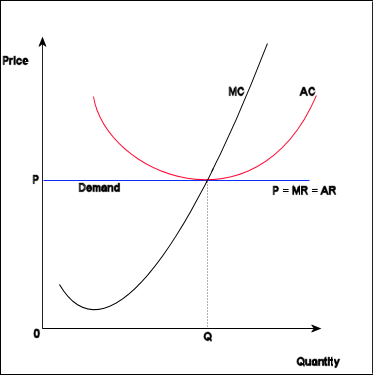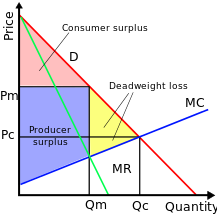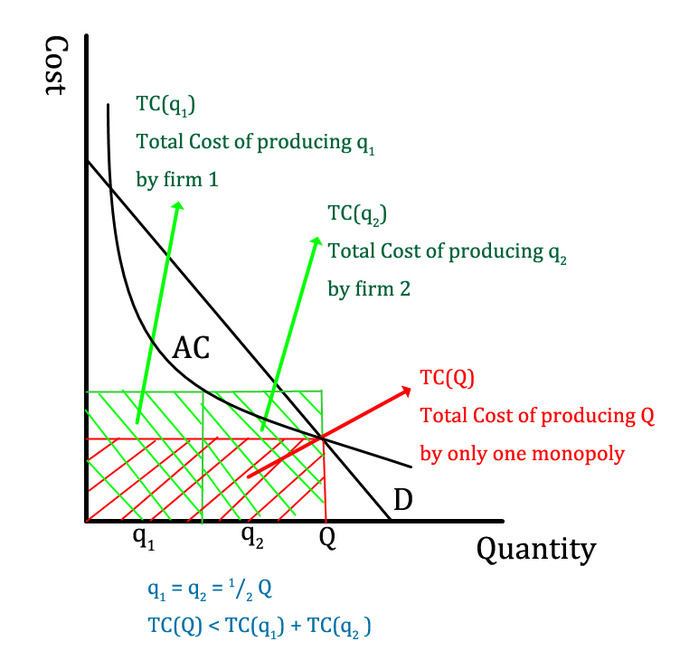Social Impacts of Monopoly
A monopoly can diminish consumer choice, reduce incentives to innovate, and control supply to enforce inequitable prices in a society.
learning objectives
- Outline the effect of a monopoly on producer, consumer, and total surplus
The Value of Competition
To understand why trends towards consolidation are so dangerous it is useful to frame why competition is of such critical value to equitable markets, particular from a consumer perspective. In a perfectly competitive market, the antithesis of a monopoly, demand is completely elastic and the production quantity and price point align perfectly with marginal costs and actual costs. This allows for revenues, costs, price, and quantity to achieve a balance where the consumer is provided with the optimal amount of a good at the most equitable price.

Perfect Competition Economics: This is a graphical illustration of economics within the context of a perfectly competitive market (theoretically). Note that the overall returns derived, costs incurred, quantity produced, and price point all align perfectly to generate an equitable market position. While this is an idealistic representation of markets, it is useful as a frame of reference to identify departures from ideal competitive circumstances.
However, perfect competition is more of a theoretical competitive framework because markets will naturally deviate to varying degrees (in order to capture profitable returns). As such, the perfect competition model is most useful in identifying and measuring deviations or departures from the competitive ideal. The farther an industry or market moves from a perfectly competitive model the more value is potentially migrating from the consumers to the suppliers. In order to ensure that suppliers do not take on too much power (such as the case of monopolies and oligopolies), government regulations and antitrust laws are a necessary component of the economic perspective.
Societal Risks of Monopolies
The accumulation of power and leverage on behalf of the suppliers largely revolves around the fact that monopolies can ultimately control supply in its entirety for a specified product or service. Through utilizing this control strategically, a profit-maximizing monopoly could create the following societal risks:
- Price Discrimination: This concept is often strongly emphasized as a potential economic risk of monopolies and the economic justification is easily illustrated. Picture a supply and demand chart, where supply and demand intersect to generate a fair price point and overall quantity provided. Now assume one company has the entire supply under it’s control, and can discriminate prices along the demand curve to capture higher prices than the available supply should allow. This allows monopolies to charge customers with a higher willingness to pay a higher price, while still charging consumers with a lower willingness to pay the standard prices. This is unfair to consumers, who will be forced to pay whatever is asked as a result of no alternative options.
- Reduced Efficiency: A less direct societal risk of monopolies is the fact that competition is closely linked to incentives. As a result, no competition will provide the monopoly very little reason to improve internal inefficiencies or cut costs. A competitive market will see constant strives to reduce costs in order to capture higher market share and provide goods at lower prices, while monopolies do not have this incentive.
- Reduced Innovation: A monopoly will also have limited motivation to innovate, as there is little value in differentiation in a thoroughly controlled market (for the only incumbent). As a result there is reduced improvements that could substantially improve the ability of the firm to fulfill the needs of the consumer.
- Deadweight Loss: A monopoly will choose to produce less and charge more than would occur in a perfectly competitive market. As a result, a monopoly causes deadweight loss, an inefficient economic outcome.
In summarizing these various societal drawbacks, monopolies pose the risk of reducing consumer choice and consumer power to incentivize companies to innovate and reduce costs, as there is limited prospective returns on investment. A monopoly with total control over the supply can charge any price that the consumer is willing to pay, and therefore can generate excessive margins while doing very little to improve their product/service or relevant processes.
Antitrust Laws
Antitrust laws ensure that competitive environments are preserved in order to maintain an efficient and equitable capitalistic system.
learning objectives
- Discuss antitrust laws aimed to improve competition and prevent monopolies from becoming more powerful
Antitrust laws perform the critical task of ensuring that competitive environments are preserved in order to maintain an efficient and equitable capitalistic system for firms to operate in. The concept of antitrust largely revolves around governmental restrictions that limit incumbents in any given industry from consolidating too much power.
The worst case scenario of consolidation results in a monopoly, which is when one company or organization becomes the sole supplier of a given product or service. In such a situation it is relatively easy for that provider to erect barriers to entry for new entrants and dictate price points through manipulating the supply. The adverse effects of these manipulations can be seen in, which underlines the economic threat monopolies pose the end consumer. Antitrust law is in place to ensure such circumstances do not arise, or when they do that they are regulated appropriate to minimize adverse societal effects.

Regulating Competition
The regulation of competitive markets has roots as far back as the Roman Empire, resulting in increasingly complex models as capitalism has evolved over time. Indeed, due to the increasingly international focus for many large corporations, antitrust laws and other competitive regulations must function not only at the country level but on a global level. Organizations such as the World Trade Organization (WTO) attempt to garner international support for the establishment of global standards in competitive markets in conjunction with the internal competitive laws which govern each nation individually. While these antitrust laws differ from nation to nation, they can loosely be summarized in three components:
- Actively ensuring that no agreements in place are counter to a competitive market. This revolves largely around avoiding cartels, or collaboration between the big players which would allow for market manipulation.
- Regulating against strategic actions that may result in diminishing the competitive elements of a market. This is usually targeted at dominate players in an industry, who may have a tendency to price gauge or other manipulations.
- Overseeing mergers, acquisitions, joint ventures and other strategic alliances to avoid consolidation that may be damaging to free markets.
Relevant Statutes
European Union (EU) – In the EU, competition law began in 1951 with the European Coal and Steel Community (ECSC), which included France, Italy, Belgium and the Netherlands. The purpose of this was to reduce the ability for one country/region to gain a monopoly on critical natural resources. Shortly after, in 1957, the European Economic Community (ECC) was established as a part of the Treaty of Rome. This document enacted provisions to eliminate anti-competitive agreements. This was more recently updated via the Treaty of Lisbon, which further addresses mergers and acquisitions and bans price fixing and collusion.
United States (U.S.) – In the U.S., antitrust policy finds its roots in 1890 with the Sherman Antitrust Act. While the basic premise was the same as modern day competitive law, it was fairly rudimentary in scale and scope. The Sherman Act dealt with avoiding or limiting the power of trusts, or essentially the creation of price-controlling cartels. This act was expanded upon in 1914, with two more competitive laws: The Clayton Antitrust Act and the Federal Trade Commission Act. Both of these acts sought to organize a governmental body equipped to protect consumers from unfair competitive practices.
Regulation of Natural Monopoly
Natural monopolies are conducive to industries where the largest supplier derives cost advantages and must be regulated to minimize risks.
learning objectives
- Discuss the reasons for government regulation of monopolies
A monopoly is a business or organization that maintains exclusivity of the supply of a particular product or service, and can evolve naturally or be designed specifically based on the nature of a particular market or industry. Monopolies on the whole are governed under antitrust laws, both on a national level in most countries and on an international level via institutions such as the World Trade Organization (WTO).
The evolution of a monopoly is a critical component in recognizing which industries are at high risk of monopolization, and how these risks may be realized operationally. A natural monopoly is defined by an incumbent in an industry where the largest supplier can theoretically create the lowest production prices, generally through economies of scale or economies of scope. In this type of circumstance, the industry naturally lends itself to providing advantages for the single largest provider at the cost of allowing for competitive forces. Natural monopolistic conditions are therefore at high risk of creating actual monopolies, and society benefits from regulating these situations to even the playing field.

Price Advantage for Natural Monopolies: While monopolies are generally poor economic constructs for creating value, natural monopolies are predicated on the fact that a single supplier can achieve the greatest economies of scale (cost advantages). This graph demonstrates this concept.
Regulating Natural Monopolies
The consolidation of an industry into one sole supplier can represent a substantial threat to free markets and their consumers, as price can be easily manipulated through a thorough control of the supply. As a result, monopolies are generally viewed as illegal entities. Regulating industries to minimize monopolization and maintain competitive equality can be pursued in a number of ways:
- Average cost pricing: As the name implies, this regulatory approach is defined as enforcing a price point for a given product or service that matches the overall costs incurred by the company producing or providing. This reduces the pricing flexibility of a company and ensures that the monopoly cannot capture margins above and beyond what is reasonable.
- Price ceiling: Another way a natural monopoly may be regulated is through the enforcement of a maximum potential price being charged. A price ceiling is a regulatory strategy of stating a specific product or service cannot be sold for above a certain price.
- Rate of return regulations: This is quite similar to average cost pricing, but deviates via allowing a model that can create consistent returns for the company involved. The percentage net profit brought in a by company must be below a government specified percentage to insure compliance with this regulatory approach (i.e. 5%).
- Tax or subsidy:The last way a governmental body can alleviate a natural monopoly is through higher taxes on larger players or subsidies for smaller players. In short, the government can provide financial support via subsidies to new entrants to ensure the competitive environment is more equitable.
As with most regulatory approaches, none of these are perfect solutions and consolidation within industries conducive to a natural monopoly will continue to arise. Antitrust laws and the careful control of mergers, acquisitions, joint ventures, and other strategic alliances are critical in the regulation of natural monopolies. In extreme circumstances it is also a viable option for governments to break up monopolies through the legal processes.
When A Monopoly Works
While the concept of a monopoly is generally perceived as a threat to free markets, there are specific circumstances where natural monopolies are either pragmatically useful (cost effective) or virtually unavoidable. In these circumstances the regulatory approaches above (price ceilings, average cost pricing, etc.) are even more critical to ensuring consumers are protected. AT&T is a classic example of a government-backed monopoly in the middle of the 20th century, as the fixed investment of land lines for phones at that time was substantial. It was not practical to foster competition as a result, and the government recognized the necessity for a monopoly (until 1984, when AT&T was divested).
Key Points
- In a perfectly competitive market, the antithesis of a monopoly, demand is completely elastic and the production quantity and price point align perfectly with marginal costs and actual costs.
- Perfect competition is a theoretical competitive framework. However, markets will naturally deviate to varying degrees (in order to capture profitable returns). As such, the perfect competition model is most useful in identifying and measuring deviations or departures from the competitive ideal.
- The accumulation of power and leverage on behalf of the suppliers largely revolves around the fact that monopolies can ultimately control supply in its entirety for a specified product or service.
- A monopoly with total control over the supply can charge any price that the consumer is willing to pay, and therefore can generate excessive margins while doing very little to improve their product/service or relevant processes.
- The concept of antitrust largely revolves around governmental restrictions that limit incumbents in any given industry from consolidating too much power.
- Organizations such as the World Trade Organization (WTO) attempt to garner international support for the establishment of global standards in competitive markets in conjunction with the internal competitive laws which govern each nation individually.
- In the U.S., antitrust policy finds its roots in 1890 with the Sherman Antitrust Act, and saw substantial expansion in 1914 via the Clayton Antitrust Act and the Federal Trade Commission Act.
- As capitalistic markets evolve they show some tendency towards consolidation, and this consolidation puts consumers at risk of hugely powerful corporate suppliers. Antitrust policy is designed to intervene on behalf of the consumer.
- As capitalistic markets evolve they show some tendency towards consolidation, and this consolidation puts consumers at risk of hugely powerful corporate suppliers. Antitrust policy is designed to intervene on behalf of the consumer.
- A natural monopoly is defined by an incumbent in an industry where the largest supplier can theoretically create the lowest production prices, generally through economies of scale or economies of scope.
- Natural monopolistic conditions are therefore at high risk of creating actual monopolies, and society benefits from regulating these situations to even the playing field.
- Regulating industries to minimize monopolization and maintain competitive equality can be pursued through average cost pricing, price ceilings, rate of return regulations, taxes and subsidies.
- While the concept of a monopoly is generally perceived as a threat to free markets, there are specific circumstances where natural monopolies are either pragmatically useful (cost effective) or virtually unavoidable.
Key Terms
- price discrimination: The practice of selling identical goods or services at different prices from the same provider.
- Antitrust: A law opposed to or against the establishment or existence of trusts (monopolies), usually referring to legislation.
- monopoly: A situation, by legal privilege or other agreement, in which solely one party (company, cartel etc. ) exclusively provides a particular product or service, dominating that market and generally exerting powerful control over it.
- consolidation: The combination of multiple businesses.
- economies of scale: The characteristics of a production process in which an increase in the scale of the firm causes a decrease in the long run average cost of each unit.
- subsidy: Government assistance to a business or economic sector.
LICENSES AND ATTRIBUTIONS
CC LICENSED CONTENT, SPECIFIC ATTRIBUTION
- price discrimination. Provided by: Wikipedia. Located at: en.Wikipedia.org/wiki/price%20discrimination. License: CC BY-SA: Attribution-ShareAlike
- Monopoly. Provided by: Wikipedia. Located at: en.Wikipedia.org/wiki/Monopoly. License: CC BY-SA: Attribution-ShareAlike
- Antitrust. Provided by: Wikipedia. Located at: en.Wikipedia.org/wiki/Antitrust. License: CC BY-SA: Attribution-ShareAlike
- Perfect competition. Provided by: Wikipedia. Located at: en.Wikipedia.org/wiki/Perfect_competition. License: CC BY-SA: Attribution-ShareAlike
- Provided by: Wikimedia. Located at: upload.wikimedia.org/wikipedi...ompetition.png. License: CC BY-SA: Attribution-ShareAlike
- United States antitrust law. Provided by: Wikipedia. Located at: en.Wikipedia.org/wiki/United_..._antitrust_law. License: CC BY-SA: Attribution-ShareAlike
- Antitrust. Provided by: Wikipedia. Located at: en.Wikipedia.org/wiki/Antitrust. License: CC BY-SA: Attribution-ShareAlike
- Monopoly. Provided by: Wikipedia. Located at: en.Wikipedia.org/wiki/Monopoly. License: CC BY-SA: Attribution-ShareAlike
- Antitrust. Provided by: Wiktionary. Located at: en.wiktionary.org/wiki/Antitrust. License: CC BY-SA: Attribution-ShareAlike
- Boundless. Provided by: Boundless Learning. Located at: www.boundless.com//psychology.../consolidation. License: CC BY-SA: Attribution-ShareAlike
- Boundless. Provided by: Boundless Learning. Located at: www.boundless.com//economics/...ition/monopoly. License: CC BY-SA: Attribution-ShareAlike
- Provided by: Wikimedia. Located at: upload.wikimedia.org/wikipedi...ompetition.png. License: CC BY-SA: Attribution-ShareAlike
- Provided by: Wikimedia. Located at: upload.wikimedia.org/wikipedi...-surpluses.svg. License: CC BY-SA: Attribution-ShareAlike
- Living Economics: Profit Maximization Under Natural Monopoly - youtube (transcript). Provided by: Living Economics. Located at: http://livingeconomics.org/article.asp?docId=431. License: CC BY-SA: Attribution-ShareAlike
- Natural monopoly. Provided by: Wikipedia. Located at: en.Wikipedia.org/wiki/Natural_monopoly. License: CC BY-SA: Attribution-ShareAlike
- Monopoly. Provided by: Wikipedia. Located at: en.Wikipedia.org/wiki/Monopoly. License: CC BY-SA: Attribution-ShareAlike
- Strategy for Information Markets/Monopoly. Provided by: Wikibooks. Located at: en.wikibooks.org/wiki/Strateg...tural_monopoly. License: CC BY-SA: Attribution-ShareAlike
- Natural monopoly. Provided by: Wikipedia. Located at: en.Wikipedia.org/wiki/Natural_monopoly. License: CC BY-SA: Attribution-ShareAlike
- economies of scale. Provided by: Wikipedia. Located at: en.Wikipedia.org/wiki/economies%20of%20scale. License: CC BY-SA: Attribution-ShareAlike
- subsidy. Provided by: Wiktionary. Located at: en.wiktionary.org/wiki/subsidy. License: CC BY-SA: Attribution-ShareAlike
- Provided by: Wikimedia. Located at: http://upload.wikimedia.org/wikipedi...ompetition.png. License: CC BY-SA: Attribution-ShareAlike
- Provided by: Wikimedia. Located at: upload.wikimedia.org/wikipedi...-surpluses.svg. License: CC BY-SA: Attribution-ShareAlike
- Provided by: Wikimedia. Located at: upload.wikimedia.org/wikipedi...l_monopoly.jpg. License: CC BY-SA: Attribution-ShareAlike





